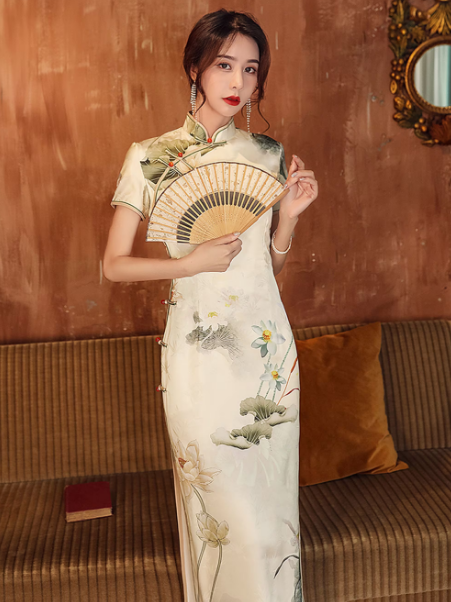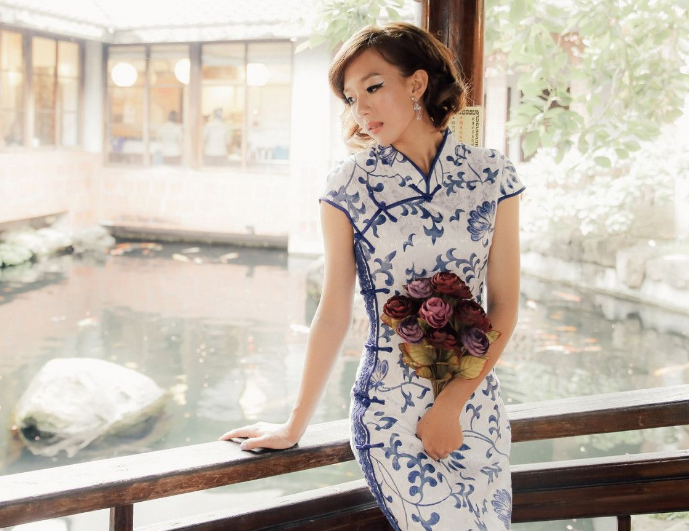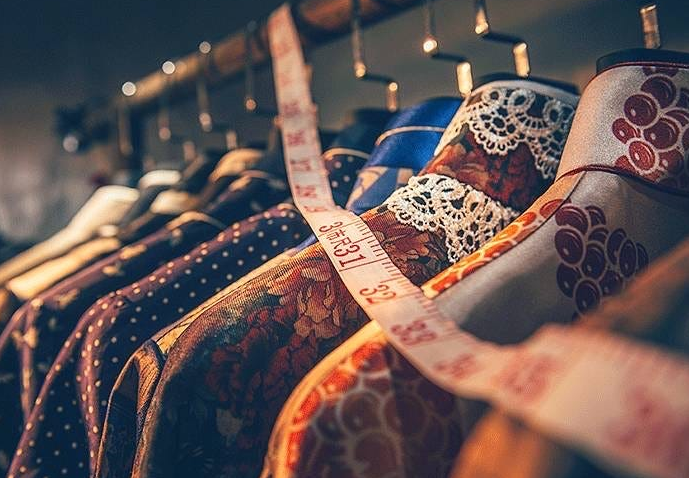Historical Overview
The Formation of the Republic of China
The Republic of China (ROC) emerged in 1912, following the collapse of the Qing Dynasty. This significant political shift marked the end of over two thousand years of imperial rule in China. The foundation of the ROC introduced a wave of socio-political reforms that significantly influenced various aspects of life, including clothing. Sun Yat-sen, the first President of the ROC, often donned a suit symbolizing modernity and a break from traditional Qing attire. This shift represented a broader desire among Chinese citizens to modernize and embrace new ideas. For more information on this topic, visit Republic of China’s Formation.

Influences on Fashion Trends
Fashion during the early years of the Republic of China was a mix of traditional Chinese elements and Western influences. As cities like Shanghai became cosmopolitan centers, Western-style suits, dresses, and hats started appearing alongside traditional Chinese garments. The 1920s and 1930s saw the rise of the cheongsam (qipao) as a popular women’s dress, reflecting both the modern influence and the retention of Chinese identity. Men commonly wore the Sun Yat-sen suit (later known as the Mao suit), which combined Western-style tailoring with a distinct Chinese look, often made from materials such as silk and cotton, ensuring quality and comfort. Western attire’s influence reflected China’s engagement with global trends, marking a period of significant cultural and social evolution. For further details on these trends, see Fashion in the Republic of China.
Traditional Attire
The traditional attire in the Republic of China represents a rich cultural heritage, blending aesthetics, symbolism, and practicality. These clothes not only serve as daily wear but also play a crucial role in festivals, rituals, and ceremonial occasions. Traditional Chinese garments stand out for their elegance, vibrant colors, and unique designs that vary across different ethnic groups and regions.
Men’s Clothing Styles
Traditional men’s clothing in the Republic of China often showcased simplicity and modesty. The changshan, a long robe with a mandarin collar, was a common choice. It usually featured fine silk or cotton, showcasing both the quality and comfort essential in Chinese attire. Men also frequently wore the Zhongshan suit, known in the West as the “Mao suit,” especially in the mid-20th century. It combined functionality with a sense of nationalism and became a symbol of modern Chinese identity. For more details, visit Changshan.
Women’s Clothing Styles
For women, the qipao or cheongsam was the most iconic traditional outfit in the Republic of China. It evolved from a loose-fitting style to a more tailored, form-fitting dress. Made usually from high-quality silk or brocade, it featured intricate embroidery and vivid patterns, showcasing artistic craftsmanship. Women’s attire often included accessories like jade jewelry, enhancing both the aesthetic appeal and the cultural significance of the ensemble. The qipao remains a symbol of Chinese feminine elegance and is popular worldwide for its distinct beauty and historical value. Learn more at Qipao/Cheongsam.
The Cheongsam (Qipao)
The cheongsam, or qipao, is a traditional Chinese dress and a quintessential symbol of Chinese feminine fashion. It has evolved significantly since its origins in the 17th century during the Qing Dynasty. Originally a loose-fitting, long robe, the modern cheongsam developed into a more form-fitting and shorter dress. This evolution mirrors broader changes in Chinese society, especially in women’s social status and self-expression. The qipao beautifully merges the artistic elements of Chinese embroidery with the elegance of traditional silk, making it a unique piece of cultural heritage.
Evolution and Significance
The evolution of the qipao reflects major socio-cultural changes in China. From the loose-fitting garment of the Qing Dynasty to the tighter, high-necked version popularized in the 1920s in Shanghai, the qipao’s transformation symbolizes women’s changing role and emancipation in Chinese society. It transitioned from a symbol of traditionalism to one of modernity and fashion. The significance of the qipao extends beyond mere clothing; it represents a fusion of history, art, and cultural identity. The garment has remained a proud emblem of Chinese heritage throughout political, social, and fashion changes.
Modern Interpretations and Designs
In contemporary fashion, designers often reinterpret the qipao, balancing traditional aesthetics with modern trends. Today’s qipaos come in a variety of fabrics, from traditional silk to more modern blends, accommodating diverse tastes and occasions. Designers experiment with lengths, colors, and patterns, introducing elements like sleeveless designs, varying hemlines, and integrated Western motifs. These modern interpretations ensure the qipao remains relevant and cherished in the fashion world, continuing its legacy as an icon of style and cultural identity. For additional insights, explore Modern Qipao Designs.
Military and Political Uniforms
Military and political uniforms in the Republic of China have played a vital role in representing authority, discipline, and national identity. These uniforms, varying across branches like the army, navy, and political leaders, are not just functional attire but symbols of honor, respect, and power. The designs, colors, and insignia of these uniforms typically reflect rank, service, and the specific roles of the wearers. Each element of the uniform, from buttons to badges, holds significance and adheres to a strict protocol.
Army and Navy Attire
The army uniforms of the Republic of China traditionally feature earthy or green tones, symbolizing their land-based operations. They often include combat uniforms, dress uniforms, and service uniforms, each designed for specific duties and occasions. The combat uniforms focus on functionality and durability, often made from quality materials that withstand tough conditions. Navy attire, distinguishing itself with darker blues and whites, emphasizes both functionality at sea and ceremonial elegance. The attire of both branches includes specific badges and insignia, indicating rank, specialties, and unit affiliations.
Uniforms of Political Leaders
The uniforms of political leaders in the Republic of China, particularly during the early and mid-20th century, were not just clothing but a statement of ideology and leadership. Figures like Chiang Kai-shek and Mao Zedong were often seen in the Sun Yat-sen suit, which symbolized both revolutionary ideals and national unity. These uniforms, while simpler in design than military attire, carried immense symbolic weight. They projected authority, national pride, and a break from traditional imperial garb, aligning more with the ideals of the Republic and the move towards modernization. For further reading, check Political Leaders’ Attire in the Republic of China.

Western Influences and Adaptation
The encounter and interaction with Western cultures had a profound impact on the fashion of the Republic of China. Beginning in the late Qing Dynasty and accelerating during the Republic era, Western clothing styles began influencing Chinese fashion. This period saw a fascinating blend of traditional Chinese attire with Western sartorial elements, reflecting the social and cultural shifts of the time. It wasn’t just a fusion of styles but also a symbol of China’s adaptation to modernity and global trends.
Integration of Western Styles
The integration of Western styles with traditional Chinese clothing became evident in the early 20th century. Men started adopting suits and ties, a clear departure from the traditional robes. This change symbolized a move towards a more international and modern identity. Women began to experiment with blouses and skirts, incorporating Western elements into their wardrobes. This fusion highlighted not only a change in fashion but also shifting gender norms and a new sense of women’s independence and style.
Impact on Contemporary Fashion
The impact of these Western influences continues in contemporary Chinese fashion. Today’s designers often draw inspiration from this historical blend, creating innovative and globally appealing fashion pieces. Contemporary Chinese fashion, while modern in feel, still often pays homage to its historical roots, whether through the use of traditional motifs, patterns, or cuts. This ongoing dialogue between the traditional and the modern in Chinese fashion mirrors the country’s journey through history and its continuous evolution in the global fashion scene. For a deeper understanding, consider reading about Contemporary Fashion in China.
Preserving Traditional Attire
Preserving traditional attire in the Republic of China is crucial in maintaining a tangible connection to the nation’s history and cultural identity. Traditional garments like the qipao, hanfu, and various minority costumes not only tell stories of the past but also highlight the diversity and richness of Chinese culture. These pieces serve as a reminder of historical events, social norms, and artistic evolution through the ages. Efforts to preserve these attires involve both safeguarding existing artifacts and encouraging the contemporary wearing and production of traditional styles.

Role in Modern Culture
Traditional Chinese attire plays a dynamic role in modern culture, offering a sense of identity and continuity in a rapidly changing society. In fashion, entertainment, and even day-to-day life, elements of traditional dress often blend with modern styles, creating a unique cultural expression. Events like the Lunar New Year, weddings, and festivals often see a resurgence in traditional attire, celebrating both heritage and contemporary life. Such practices not only keep traditions alive but also enable younger generations to explore and appreciate their cultural heritage.
Conservation and Revival Efforts
Conservation and revival efforts for traditional attire take various forms, from government initiatives to grassroots movements. Museums and cultural exhibitions play a pivotal role in educating the public and showcasing the artistry and history of traditional Chinese clothing. Additionally, fashion designers and enthusiasts often advocate for the revival of these styles, incorporating traditional elements into modern wear. These efforts ensure that traditional Chinese attire remains not only a memory of the past but also a living, evolving part of China’s cultural landscape. To delve further into conservation efforts, one might explore Cultural Preservation in China.